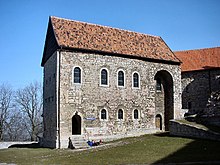Großlohra
Großlohra | ||
|---|---|---|
Location of Großlohra within Nordhausen district  | ||
Municipal assoc. Hainleite | | |
| Government | ||
| • Mayor (2020–26) | Gerald Grabe[1] | |
| Area | ||
| • Total | 18.29 km2 (7.06 sq mi) | |
| Elevation | 310 m (1,020 ft) | |
| Population (2022-12-31)[2] | ||
| • Total | 849 | |
| • Density | 46/km2 (120/sq mi) | |
| Time zone | UTC+01:00 (CET) | |
| • Summer (DST) | UTC+02:00 (CEST) | |
| Postal codes | 99759 | |
| Dialling codes | 036338 | |
| Vehicle registration | NDH | |
Großlohra is a municipality in the district of Nordhausen, in Thuringia, Germany, situated on the northern edge of the Hainleite ridge about 20 km (12 mi) southwest of the district capital. It consists of the settlements of Friedrichslohra, Großwenden, Kleinwenden, as well as Münchenlohra with its former convent basilica St. Gangulphus and castle Lohra with its accompanying manor (Amt Lohra), all of which were united in 1950.
Geography
Castle Lohra overlooks the gap between the Dün and Hainleite ridges, being situated on the northwesternmost spur of the latter. Historically, it guarded an important connection between Mühlhausen and the Halle-Kassel trade route in the Wipper valley, whose current incarnation is the Bundesautobahn 38. It was also a strategically important vantage point overlooking the plains between Hainleite and Harz.[citation needed]
History

The site of castle Lohra had presumably already been fortified in

The names of Großwenden and Kleinwenden point to originally
Friedrichslohra was a settlement initiated under the reign of
References
- ^ = 2 Gewählte Bürgermeister - aktuelle Landesübersicht, Freistaat Thüringen, accessed 14 July 2021.
- Thüringer Landesamt für Statistik. June 2023.

